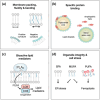The expanding organelle lipidomes: current knowledge and challenges
- PMID: 37530856
- PMCID: PMC10397142
- DOI: 10.1007/s00018-023-04889-3
The expanding organelle lipidomes: current knowledge and challenges
Abstract
Lipids in cell membranes and subcellular compartments play essential roles in numerous cellular processes, such as energy production, cell signaling and inflammation. A specific organelle lipidome is characterized by lipid synthesis and metabolism, intracellular trafficking, and lipid homeostasis in the organelle. Over the years, considerable effort has been directed to the identification of the lipid fingerprints of cellular organelles. However, these fingerprints are not fully characterized due to the large variety and structural complexity of lipids and the great variability in the abundance of different lipid species. The process becomes even more challenging when considering that the lipidome differs in health and disease contexts. This review summarizes the information available on the lipid composition of mammalian cell organelles, particularly the lipidome of the nucleus, mitochondrion, endoplasmic reticulum, Golgi apparatus, plasma membrane and organelles in the endocytic pathway. The lipid compositions of extracellular vesicles and lamellar bodies are also described. In addition, several examples of subcellular lipidome dynamics under physiological and pathological conditions are presented. Finally, challenges in mapping organelle lipidomes are discussed.
Keywords: Cellular organelles; Lipidomics; Lipids; Mass spectrometry; Subcellular fractionation.
© 2023. The Author(s).
Conflict of interest statement
The authors have no relevant financial or nonfinancial interests to disclose.
Figures






References
Publication types
MeSH terms
Substances
Grants and funding
LinkOut - more resources
Full Text Sources

